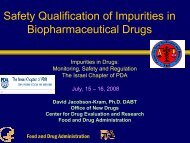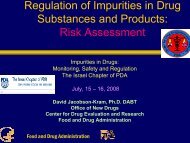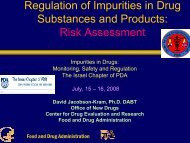ICH Q11 Presentation by Alex Weisman - The Israel Chapter of PDA
ICH Q11 Presentation by Alex Weisman - The Israel Chapter of PDA
ICH Q11 Presentation by Alex Weisman - The Israel Chapter of PDA
You also want an ePaper? Increase the reach of your titles
YUMPU automatically turns print PDFs into web optimized ePapers that Google loves.
<strong>Q11</strong> Development and manufacture <strong>of</strong><br />
Drug product<br />
<strong>PDA</strong> Meeting ,<br />
July 26, 2011<br />
Presented <strong>by</strong> <strong>Alex</strong> <strong>Weisman</strong>, Ph D<br />
Vice President R&D,<br />
Chemagis Ltd.<br />
1
<strong>Q11</strong> Development and manufacture <strong>of</strong><br />
Drug product: Chemagis overview<br />
• Founded in 1987, Chemagis is a subsidiary <strong>of</strong> Perrigo <strong>Israel</strong><br />
(PIL) , <strong>Israel</strong>'s second largest pharmaceutical conglomerate and<br />
part <strong>of</strong> the Perrigo Group.<br />
• Chemagis develops, produces and markets an extensive line <strong>of</strong><br />
high-quality Active Pharmaceutical Ingredients (APIs) mainly for<br />
generic pharmaceutical industries.<br />
• Its products comply with the exacting regulatory requirements<br />
<strong>of</strong> leading health authorities.<br />
2
What’s new?<br />
• This guideline describes approaches to<br />
developing process and drug substance<br />
understanding and also provides guidance on<br />
what information should be provided in CTD<br />
sections 3.2.S.2.2 – 3.2.S.2.6. It provides further<br />
clarification on the principles and concepts<br />
described in <strong>ICH</strong> guidelines on Pharmaceutical<br />
Development (Q8), Quality Risk Management<br />
(Q9) and Pharmaceutical Quality Systems (Q10)<br />
as they pertain to the development and<br />
manufacture <strong>of</strong> drug substance.<br />
3
<strong>Q11</strong><br />
• A company can choose to follow different approaches in developing<br />
a drug substance. For the purpose <strong>of</strong> this guideline, the terms<br />
“traditional” and “enhanced” are used to differentiate two possible<br />
approaches. In a traditional approach, set points and operating<br />
ranges for process parameters are defined and the drug substance<br />
control strategy is typically based on demonstration <strong>of</strong> process<br />
reproducibility and testing to meet established acceptance criteria. In<br />
an enhanced approach, risk management and more extensive<br />
scientific knowledge are used to select process parameters and unit<br />
operations that impact critical quality attributes (CQAs) for<br />
evaluation in further studies to establish any design space(s) and<br />
control strategies applicable over the lifecycle <strong>of</strong> the drug substance.<br />
As discussed in <strong>ICH</strong> Q8 for drug product, a greater understanding <strong>of</strong><br />
the drug substance and its manufacturing process can create the<br />
basis for more flexible regulatory approaches. <strong>The</strong> degree <strong>of</strong><br />
regulatory flexibility is generally predicated on the level <strong>of</strong> relevant<br />
scientific knowledge provided in the application for marketing<br />
authorisation<br />
4
• DS = Drug substance<br />
• DS = Design space<br />
DS x DS = DS 2<br />
5
3.1 General principles<br />
<strong>Q11</strong><br />
3.1.1 DS Quality link to Drug product<br />
3.1.2 Process development tools:<br />
Quality risk management<br />
Knowledge management<br />
6
<strong>Q11</strong>: Approaches to development<br />
• <strong>ICH</strong> Q8 recognizes that “Strategies for product<br />
development vary from company to company<br />
and from product to product. <strong>The</strong> approach to,<br />
and extent <strong>of</strong>, development can also vary and<br />
should be outlined in the submission.” <strong>The</strong>se<br />
concepts apply equally to the development <strong>of</strong><br />
the drug substance manufacturing process. An<br />
applicant can choose either a traditional<br />
approach or an enhanced approach to drug<br />
substance development, or a combination <strong>of</strong><br />
both.<br />
7
<strong>Q11</strong> Development and manufacture <strong>of</strong> Drug<br />
Substances<br />
• <strong>The</strong> guideline describes approaches…<br />
• Which approach is preferable?<br />
Traditional or enhanced?<br />
<strong>The</strong> answer: implement whatever is good<br />
for your company!!!<br />
What is good? What are the criteria to make a decision?<br />
- No compromises in Quality;<br />
- Low cost;<br />
- Shorter time to approval (=cost).<br />
If the cost for development and implementation for the<br />
“enhanced” approach is higher than for the “traditional one” –<br />
use the traditional one!<br />
8
<strong>Q11</strong> Development and manufacture <strong>of</strong> Drug<br />
Substances<br />
Considerations should be taken into account<br />
before choosing one <strong>of</strong> the approaches:<br />
• 1) RM availability and suppliers stability;<br />
• 2) “Scale up”?<br />
• 3) Future changes in Engineering design;<br />
etc.<br />
9
Traditional approach<br />
• Typical CQA’s:<br />
DS quality = safety, potency, strength, purity;<br />
- Genotoxic impurities directly effect safety;<br />
- Crystalline form and PSD can effect potency<br />
(bioavailability can be sufficiently different for the<br />
different forms <strong>of</strong> PSD <strong>of</strong> the same DS );<br />
- Related substances, residual solvents etc. directly<br />
effects the purity;<br />
CQA’s are important not only with the<br />
reference to quality, but to with the reference<br />
to the DS markets.<br />
10
CQA’s with the reference to<br />
specific markets<br />
Desired DS quality may sufficiently varies within territory:<br />
Example 1 : EP/USP description <strong>of</strong> DS: white to <strong>of</strong>f<br />
white is acceptable;<br />
Japan – <strong>of</strong>f white will not pass!!!!<br />
Example 2: Related substances level: for same DS<br />
approved in EC with <strong>ICH</strong> limits, FDA requested<br />
0.05% /0.10% as exceeding 2g/day – obesity problem in<br />
US !!!<br />
11
<strong>Q11</strong>: Manufacturing process development<br />
should include, at a minimum….<br />
• Identifying potential CQAs associated with the<br />
drug substance so that those characteristics<br />
having an impact on product quality can be<br />
studied and controlled;<br />
• Defining an appropriate manufacturing process;<br />
• Defining a control strategy to ensure process<br />
performance and drug substance quality;<br />
12
<strong>Q11</strong>: Manufacturing process development<br />
should include, at a minimum….<br />
An enhanced approach to manufacturing process development<br />
would additionally include the following elements:<br />
A systematic evaluation, understanding and refining <strong>of</strong> the<br />
manufacturing process, including;<br />
» Identifying, through e.g. prior knowledge,<br />
experimentation and risk assessment, the material<br />
attributes and process parameters that can have an<br />
effect on drug substance CQAs;<br />
» Determining the functional relationships that link<br />
material attributes and process parameters to drug<br />
substance CQAs;<br />
• Using the enhanced approach in combination with QRM to establish<br />
an appropriate control strategy which can, for example, include a<br />
proposal for a design space(s) and/or real-time release testing<br />
(RTRT).<br />
13
<strong>Q11</strong>: Linking MA and Process<br />
parameters to DS CQAs<br />
• <strong>The</strong> manufacturing process development<br />
program should identify which material attributes<br />
(e.g., <strong>of</strong> raw materials, starting materials,<br />
reagents, solvents, process aids, intermediates)<br />
and process parameters should be controlled.<br />
Risk assessment can help identify the material<br />
attributes and process parameters with the<br />
potential for having an effect on drug substance<br />
CQAs. Those material attributes and process<br />
parameters that are found to be important to<br />
drug substance quality should be addressed <strong>by</strong><br />
the control strategy<br />
14
Material attributes and process parameters<br />
vs. CAQ’s <strong>of</strong> DS<br />
• Raw materials, reagents, solvents, catalysts<br />
used for DS production;<br />
Traditional approach – works not bad for the<br />
generic industry:<br />
Example 1: Process related impurity – N-Alkyl<br />
Cilostazol,<br />
Example 2: Reagent related impurity – S-methyl<br />
Fluticasone<br />
Example 3: RM/process related impurity -<br />
D- Cetirizine<br />
15
Material attributes and process<br />
parameters vs. CAQ’s <strong>of</strong> DS<br />
• Quality <strong>by</strong> Design: A systematic approach to development that<br />
begins with predefined objectives and emphasizes product and<br />
process understanding and process control, based on sound<br />
science and quality risk management. (<strong>ICH</strong> Q8)<br />
• <strong>The</strong> process designed in a way that being within the Critical Process<br />
Parameters (CPP) results in producing a material, meeting “Critical<br />
Quality Attribute” (CQA)<br />
• Every process at its development time should be investigated<br />
for:<br />
• Kinetics <strong>of</strong> desired product and impurities formation performed<br />
in variable conditions;<br />
• Solid state research and crystallization parameterization;<br />
• Identification <strong>of</strong> impurities;<br />
• Control <strong>of</strong> process parameters and MA’s.<br />
16
<strong>Q11</strong>: design space<br />
• For chemical entity design space development, a major<br />
focus is knowledge <strong>of</strong> formation, fate, and purge <strong>of</strong><br />
impurities through every step <strong>of</strong> a manufacturing<br />
process. It is important to understand the formation, fate<br />
(whether the impurity reacts and changes its chemical<br />
structure), and purge (whether the impurity is removed<br />
via crystallisation, extraction, etc.) as well as their<br />
relationship to the resulting impurities that end up in the<br />
drug substance as CQAs. All steps (or unit operations)<br />
should be evaluated to establish appropriate acceptance<br />
criteria for impurities as they progress through multiple<br />
process operations<br />
17
Design space for purification and<br />
crystalline form control<br />
• DS a proprietary purification method was developed.<br />
• <strong>The</strong> API character-<br />
• Hardly soluble in any “conventional” organic solvents<br />
• Easily decomposes in water and in protic solvents (as MeOH).<br />
• To get the pure material, very polar and high boiling point solvents<br />
• had to be chosen (e.g. DMF, DMAA), DMF found to be the best choice for<br />
purification.<br />
• However… residual DMF (CQA), found to be difficult to remove<br />
• We have found during defining <strong>of</strong> the design space <strong>of</strong> crystallization<br />
parameters, <strong>by</strong> DOE, that crystallization at lower temperatures and<br />
volumes enable to remove the DMF later on, <strong>by</strong> drying, to get in spec<br />
material.<br />
18
Volume<br />
15<br />
14<br />
13<br />
12<br />
11<br />
10<br />
9<br />
8<br />
-20<br />
<strong>Q11</strong>: DS 2<br />
Contour Plot <strong>of</strong> DMF vs Volume, Temp<br />
-15<br />
-10 -5<br />
Temp<br />
0<br />
5<br />
DMF<br />
< 200<br />
200 – 300<br />
300 – 400<br />
400 – 500<br />
500 – 600<br />
600 – 700<br />
700 – 800<br />
> 800<br />
19
Design space for purity control <strong>by</strong><br />
manufacturing process<br />
• Tramadol – one <strong>of</strong> ours largest product, at EOR<br />
• we get 80% desired trans and 20% cis,<br />
• Performing a step <strong>of</strong> isomeriztion- converting 20% <strong>of</strong> the<br />
• undesired cis- “<strong>by</strong> product”,<br />
• to the desired trans-product<br />
• Minimize the level <strong>of</strong> “<strong>by</strong>-product” from 20 to 13%.<br />
• <strong>The</strong> process performed today at:<br />
• 80C , 5 hr, acid <strong>of</strong> concentration <strong>of</strong> 25%.<br />
• Performing DOE experiments and defining reaction surface,<br />
• we get clearer picture <strong>of</strong> the interaction between the parameters <strong>of</strong><br />
the reaction and conclude that:<br />
• Simultaneous changes <strong>of</strong> the parameters may give better yields<br />
up to 92%.<br />
20
Isomerization Stage - Reaction Surface<br />
Isomerization stage with different temperature and acid concentration<br />
After 1 hr<br />
After 4 hr<br />
After 2 hr<br />
After 5 hr<br />
*<br />
After 3 hr<br />
*<br />
% T.trans<br />
< 80<br />
80-85<br />
85-87<br />
87-89<br />
89-92<br />
21
Design space for manufacturing<br />
process<br />
22
Design space for manufacturing<br />
process<br />
• % <strong>of</strong> water in the system strongly effects<br />
the level <strong>of</strong> Imp Y.<br />
Finally, process design includes:<br />
- Control <strong>of</strong> water in RM’s, solvents and<br />
reagents ,<br />
- Control <strong>of</strong> manufacturing equipment;<br />
23
<strong>Q11</strong>; Submission <strong>of</strong> Manufacturing<br />
process development information<br />
• 3.2.1 Overall Process Development summary<br />
• 3.2.2 List <strong>of</strong> DS CQAs;<br />
• 3.2.3 Manufacturing process history;<br />
• 3.2.4 Manufacturing process Studies;<br />
24
Q1: Description <strong>of</strong> Manufacturing<br />
Process and Process controls<br />
• <strong>The</strong> description <strong>of</strong> the manufacturing process should be<br />
provided in the form <strong>of</strong> a flow diagram and sequential<br />
procedural narrative. <strong>The</strong> in-process controls for each<br />
step or stage <strong>of</strong> the process should be indicated in the<br />
description. Scaling factors should be included for<br />
manufacturing steps intended to span multiple<br />
operational scales when the process step is scale<br />
dependent. Any design spaces in the manufacturing<br />
process should be included as part <strong>of</strong> the manufacturing<br />
process description. Example 3 gives an example <strong>of</strong> the<br />
presentation <strong>of</strong> a design space for a biotechnological<br />
product.<br />
25
<strong>Q11</strong>: Selection <strong>of</strong> SM and Source<br />
materials<br />
• Regulatory authorities assess whether the controls on<br />
the drug substance and drug substance manufacturing<br />
process can be considered adequate, including whether<br />
there are appropriate controls for impurities. To conduct<br />
this assessment, enough <strong>of</strong> the drug substance<br />
manufacturing process should be described in the<br />
application for regulatory authorities to understand how<br />
impurities are formed in the process, how changes in the<br />
process could affect the formation, fate, and purge <strong>of</strong><br />
impurities, and why the proposed control strategy is<br />
suitable for the drug substance manufacturing process.<br />
This will typically include a description <strong>of</strong> multiple<br />
chemical transformation steps;<br />
26
Selection <strong>of</strong> Starting Materials for Semi<br />
Erythromycin as RM for Azithromycin & Clarithromycin<br />
27
<strong>Q11</strong>:Justification <strong>of</strong> Information for<br />
Starting Material or Source Material<br />
28
<strong>Q11</strong>: Control Strategy<br />
29
<strong>Q11</strong>: Controls strategy<br />
• 6.1.1 Approaches to Developing Control strategy<br />
• 6.1.2 Consideration in Developing a Control Strategy<br />
30
Process Validation / Evaluation<br />
• PV is the documented evidence that process, operated<br />
within established parameters can perform effectively<br />
and reproducibly a drug substance…<br />
• To be performed before commercialization.<br />
• When should be repeated?<br />
- When manufacturing process changes have a place:<br />
scale up, changes in RM, equipment etc.<br />
• Continuous process verification vs. traditional process<br />
validation (<strong>ICH</strong> Q8)<br />
31
•Thank you!<br />
32






